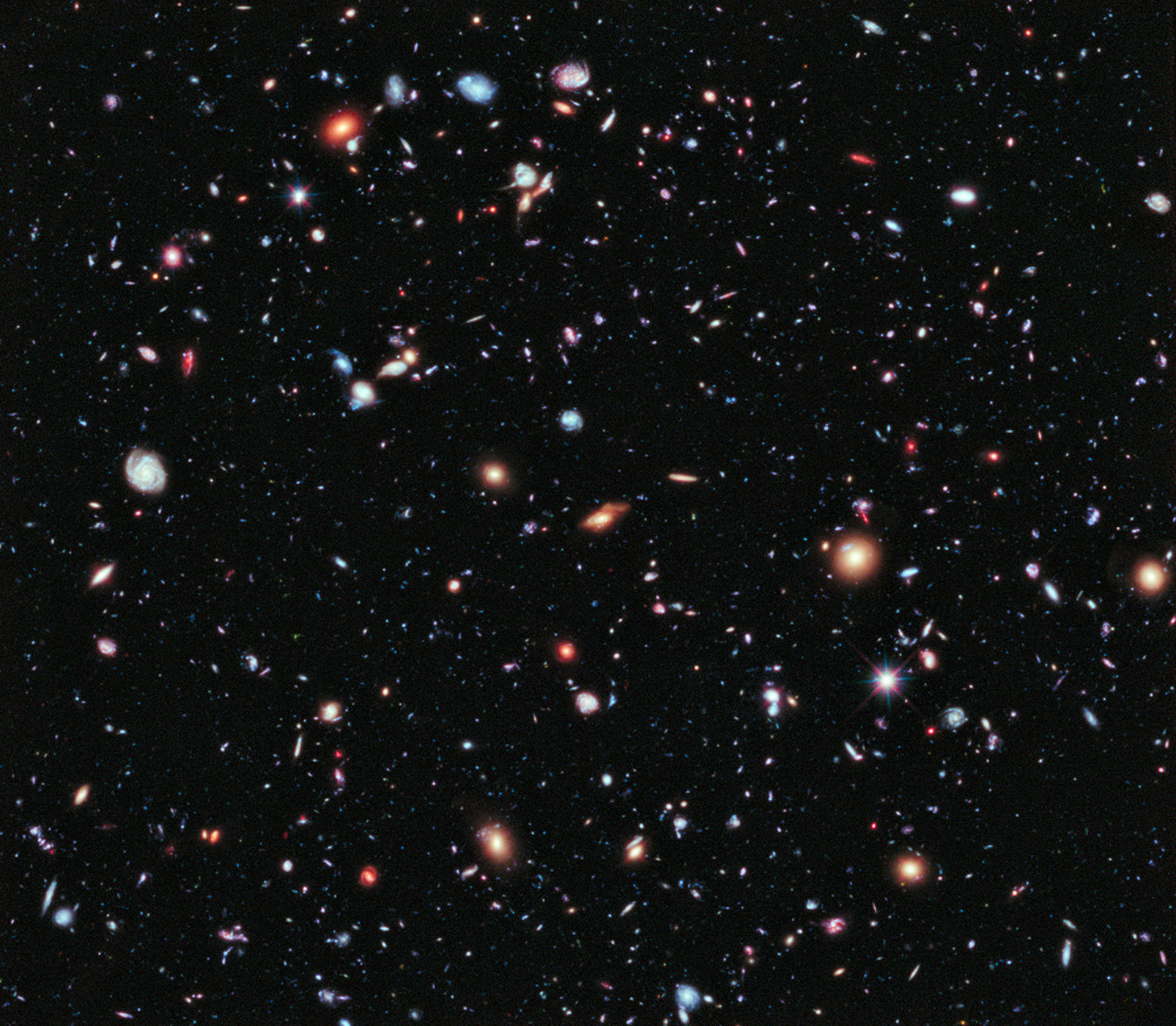We can't be all Alone!!
The same question again and again over many centuries, How can we be all alone in this never ending vast Universe. To get an idea of how big this universe is? Let's see.
XDF
 (Credit: NASA; ESA; G. Illingworth, D. Magee, and P. Oesch, University of California, Santa Cruz; R. Bouwens, Leiden University; and the HUDF09 Team)
(Credit: NASA; ESA; G. Illingworth, D. Magee, and P. Oesch, University of California, Santa Cruz; R. Bouwens, Leiden University; and the HUDF09 Team)
The Hubble Space Telescope has captured the farthest-ever view into the universe, a photo that reveals thousands of galaxies billions of light-years away.
The picture, called eXtreme Deep Field, or XDF, combines 10 years of Hubble telescope views of one patch of sky. Only the accumulated light gathered over so many observation sessions can reveal such distant objects, some of which are one ten-billionth the brightness that the human eye can see.
The photo is a sequel to the original "Hubble Ultra Deep Field," a picture the Hubble Space Telescope took in 2003 and 2004 that collected light over many hours to reveal thousands of distant galaxies in what was the deepest view of the universe so far. The XDF goes even farther, peering back 13.2 billion years into the universe's past. The universe is thought to be about 13.7 billion years old.
"The XDF is the deepest image of the sky ever obtained and reveals the faintest and most distant galaxies ever seen," Garth Illingworth of the University of California at Santa Cruz, principal investigator of the Hubble Ultra Deep Field 2009 program, said in a statement. "XDF allows us to explore further back in time than ever before."
Cosmic Eye
Another view of how big the universe is, 1 billion light years is the distance shown here. So, even light needs 1 billion years to reach earth from there which means we are looking 1 billion years in the past. Lots of things visible in the night sky could not be even there in reality and so many things which are there may not be visible as they are so far away that light from those objects takes years to travel to earth. If a star dies or born in our universe then we will not be able to notice that for almost thousands of years.
Voyager 1 is the first manmade object to travel beyond the solar system and reach Interstellar space. It is travelling at a speed of 17 km per second. The speed of light is 299792 Km per second and the nearest star to us is Proxima Centauri which is about 4.22 light years away from us. Proxima Centauri has been suggested as a logical first destination for interstellar travel, although as a flare star it would not be particularly hospitable. The current standard spaceship, the Space Shuttle, travels in orbit at 7.8 km per second. At that speed, it would take 160,000 years to reach Proxima. The fastest man-made spacecraft, the Helios II deep space probe, has set a speed record of 70.2 km per second. Even at that speed, the journey to Proxima Centauri would take 18,000 years. The proposed VASIMR propulsion system, possibly able to achieve speeds up to 300 km per second, would shorten the journey to a "mere" 4,200 years —still firmly beyond the current lifespan of both man and machine.
That was just one star we have talked about and even travelling to that isn't possible right now. There are about 10 billion galaxies in the observable universe! The number of stars in a galaxy varies, but assuming an average of 100 billion stars per galaxy means that there are about 1,000,000,000,000,000,000,000 (that's 1 billion trillion) stars in the observable universe!. Wait, here I just said observable universe!
All the stars, planets and galaxies that can be seen today make up just 4 percent of the universe. The other 96 percent is made of stuff astronomers can't see, detect or even comprehend. These mysterious substances are called dark energy and dark matter. Astronomers infer their existence based on their gravitational influence on what little bits of the universe can be seen, but dark matter and energy themselves continue to elude all detection.
We have already seen how vast the universe is and it is just 4 percent of the actual universe present out there. So, how could that be possible that we are alone? It isn't satisfying to believe that we are and it isn't yet to be proved that we aren't. The Solar System's planets (8 in total) and officially recognized dwarf planets are known to be orbited by 194 natural satellites, or moons. There is already so much in our own solar system that we can't even think about other solar systems to be explored. We are trying our best to increase the speed of travel by creating much faster space shuttles. But we can never explore the world with just speed. The speed of light is the fastest thing in the universe and even it is not enough when it comes to Interstellar space. The approach needs to be changed. It's just like walking faster and faster when you should be traveling by airplane. The theory of Wormholes seems fictional right now. But if it is true then we can explore the universe without the limit of speed, "Decreasing distance is better than increasing speed".
There may be a chance that if someone from outer space or humans from earth send signals to each other then one may not be able to receive it for millions of years and maybe by then the entire living species of that planet becomes extinct.
The question is going to be unanswered for generations and maybe the ones reading this will never be able to know the answer.